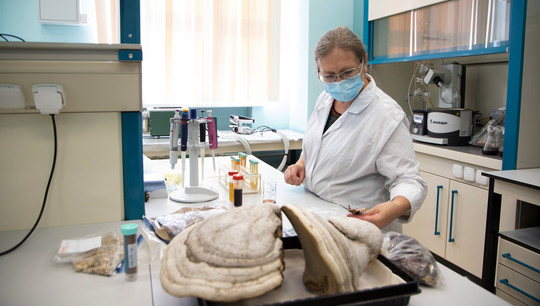Ural Federal University Expert Explains Fungi and Their Biologically Active Substances
Fungi can communicate with each other: they have signaling systems – chemical and electrical – that allow them to exchange information. These signals are not conversations in the human sense, but they allow fungi to express their needs and coordinate their growth and development. One of the most recent studies on this topic was published by Japanese scientists who recorded the “conversations” of mushrooms after rain. Irina Kiseleva, Head of the Research Laboratory “Biotechnology of Components Maintenance and Restoration of Natural and Transformed Biosystems” at UrFU, spoke about fungal communication, its useful properties and parasitic fungi.
“It is scientifically proven that fungi “communicate”. At the same time, their signals are not just a response to environmental influences. The signal can be transmitted to other cells at a sufficient distance. In general, of course, fungi are amazing organisms – it is not plants and animals. This is a very ancient kingdom of living organisms and extremely curious. For one thing, they are extremely diverse: from single-celled yeasts and molds to rough boletes, ceps, and orange-capped boletes. Fungi can be dangerous parasites or saprotrophs. It is estimated that there are between 100,000 and 1.5 million species of fungi on Earth today. Second, fungi are ubiquitous: they live in water, in the air, on the surface of the earth, in trees. The structure of fungi is such that they can grow indefinitely,” says Irina Kiseleva.
At the same time, fungi have beneficial properties for ecosystems and humans. From nature’s perspective, fungi convert the remains of living things into inorganic and simple organic compounds, enriching the soil. They also return useful elements so that other living organisms can feed on them and build their own bodies. Although mushrooms are difficult for humans to digest, they contain vitamins, amino acids and minerals. It is a low-calorie product that provides rapid satiety after consumption.
“Russula, milk mushrooms, ceps, and other mushrooms are heavy foods for humans because their cell walls are made of chitin, which our bodies cannot digest. Some bacteria and plants have the ability to break down chitin, but human cells do not. The second point is that mushrooms contain deficient proteins. There are 20 types of proteinogenic amino acids that make up proteins. Not all proteinogenic amino acids are found in mushrooms, which means that the protein is not complete, also making it difficult to digest mushrooms,” says the biologist.
From a medicinal point of view, mushrooms have beneficial properties such as antioxidant activity and can protect body cells from cancer. One such example is the wood fungus chaga: it has a misshapen mass and parasitizes trees.
“Chaga contains a large number of biologically active substances with interesting properties for medicine. For example, it is rich in antioxidants, which quench reactive oxygen species in the body and prevent oxidative stress. Chaga is also rich in polysaccharides – polymers consisting of simple sugars. These polysaccharides have anti-tumor properties,” adds Irina Kiseleva.
UrFU biologists have been studying various useful properties of the mushrooms for many years. For example, last year they found out what biologically active substances are contained in Ural wood-decomposing fungi – steroids, triterpene compounds, fatty acids, ergosterol (a provitamin form of vitamin D2) and others.
“In Russia, chaga has been used since ancient times. In theory, you can make a decoction from chaga, but the main thing is not to abuse it. Remember that not all arboreal mushrooms – those that grow on trees – are chaga. The average person, not a mycologist, will find it difficult to distinguish one species from another and figure out whether it can be used, so it is better to buy mushroom extracts in a pharmacy. In pharmacies you can also buy reishi extracts, which are used in folk medicine in China, for example. Reishi mushrooms contain complex chemical compounds – triterpenes and polysaccharides, which have anti-tumor properties. In general, China uses a large number of mushrooms as medicines,” says Irina Kiseleva.
A special story is the tea mushroom (Kombucha). It is a symbiosis of fungus and acetobacteria, which produce acetic acid. The fermentation occurs because the bacteria recycle the products of the fungus. The drink is high in antioxidants and an excellent source of probiotics. Nowadays, kombucha is more often found on the shelves of stores.

